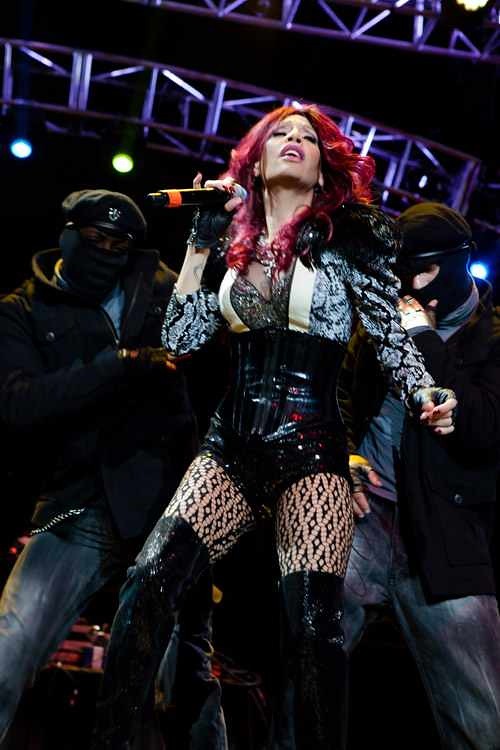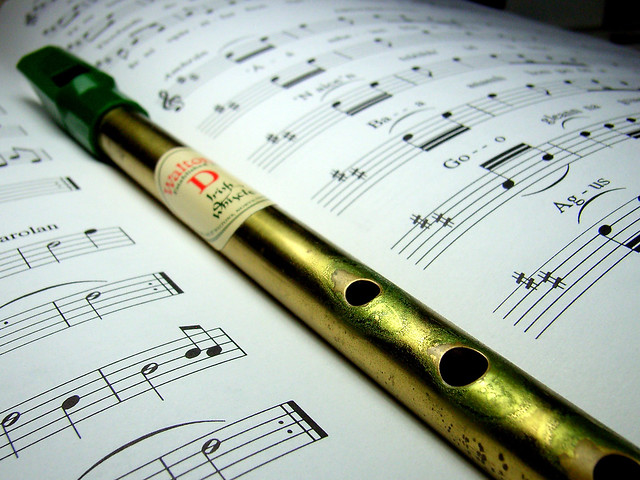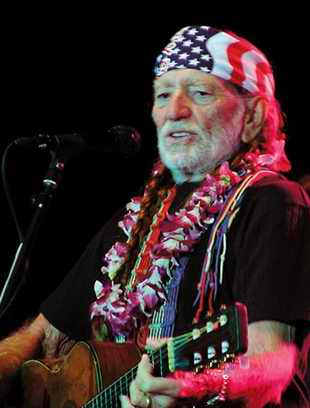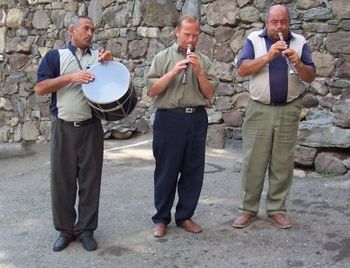 |
| Armenian folk musicians. (Photo credit: Wikipedia) |
African Folk - Music held to be typical of a nation or ethnic group, known to all segments of its society, and preserved usually by oral tradition.
Afro jazz - Refers to jazz music which has been heavily influenced by African music. The music took elements of marabi, swing and American jazz and synthesized this into a unique fusion. The first band to really achieve this synthesis was the South African band Jazz Maniacs.
Afro-beat - Is a combination of Yoruba music, jazz, Highlife, and funk rhythms, fused with African percussion and vocal styles, popularized in Africa in the 1970s.
Afro-Pop - Afropop or Afro Pop is a term sometimes used to refer to contemporary African pop music. The term does not refer to a specific style or sound, but is used as a general term to describe African popular music.
Apala - Originally derived from the Yoruba people of Nigeria. It is a percussion-based style that developed in the late 1930s, when it was used to wake worshippers after fasting during the Islamic holy month of Ramadan.
Assiko - is a popular dance from the South of Cameroon. The band is usually based on a singer accompanied with a guitar, and a percussionnist playing the pulsating rhythm of Assiko with metal knives and forks on an empty bottle.
Batuque - is a music and dance genre from Cape Verde.
Bend Skin - is a kind of urban Cameroonian popular music. Kouchoum Mbada is the most well-known group associated with the genre.
Benga - Is a musical genre of Kenyan popular music. It evolved between the late 1940s and late 1960s, in Kenya's capital city of Nairobi.
Biguine - is a style of music that originated in Martinique in the 19th century. By combining the traditional bele music with the polka, the black musicians of Martinique created the biguine, which comprises three distinct styles, the biguine de salon, the biguine de bal and the biguines de rue.
Bikutsi - is a musical genre from Cameroon. It developed from the traditional styles of the Beti, or Ewondo, people, who live around the city of Yaounde.
Bongo Flava - it has a mix of rap, hip hop, and R&B for starters but these labels don't do it justice. It's rap, hip hop and R&B Tanzanian style: a big melting pot of tastes, history, culture and identity.
Cadence - is a particular series of intervals or chords that ends a phrase, section, or piece of music.
Calypso - is a style of Afro-Caribbean music which originated in Trinidad at about the start of the 20th century. The roots of the genre lay in the arrival of African slaves, who, not being allowed to speak with each other, communicated through song.
Chaabi - is a popular music of Morocco, very similar to the Algerian Rai.
Chimurenga - is a Zimbabwean popular music genre coined by and popularised by Thomas Mapfumo. Chimurenga is a Shona language word for struggle.
Chouval Bwa - features percussion, bamboo flute, accordion, and wax-paper/comb-type kazoo. The music originated among rural Martinicans.
Christian Rap - is a form of rap which uses Christian themes to express the songwriter's faith.
Coladeira - is a form of music in Cape Verde. Its element ascends to funacola which is a mixture of funanáa and coladera. Famous coladera musicians includes Antoninho Travadinha.
Contemporary Christian - is a genre of popular music which is lyrically focused on matters concerned with the Christian faith.
Country - is a blend of popular musical forms originally found in the Southern United States and the Appalachian Mountains. It has roots in traditional folk music, Celtic music, blues, gospel music, hokum, and old-time music and evolved rapidly in the 1920s.
Dance Hall - is a type of Jamaican popular music which developed in the late 1970s, with exponents such as Yellowman and Shabba Ranks. It is also known as bashment. The style is characterized by a deejay singing and toasting (or rapping) over raw and danceable music riddims.
Traditional Chinese music played by aging Naxi musicians. Photo taken in Lijiang, Yunnan province, China.
(Photo credit: Wikipedia)
Disco - is a genre of dance-oriented pop music that was popularized in dance clubs in the mid-1970s.
Folk - in the most basic sense of the term, is music by and for the common people.
Freestyle - is a form of electronic music that is heavily influenced by Latin American culture.
Fuji - is a popular Nigerian musical genre. It arose from the improvisation Ajisari/were music tradition, which is a kind of Muslim music performed to wake believers before dawn during the Ramadan fasting season.
Funana - is a mixed Portuguese and African music and dance from Santiago, Cape Verde. It is said that the lower part of the body movement is African, and the upper part Portuguese.
Funk - is an American musical style that originated in the mid- to late-1960s when African American musicians blended soul music, soul jazz and R&B into a rhythmic, danceable new form of music.
Gangsta rap - is a subgenre of hip-hop music which developed during the late 1980s. 'Gangsta' is a variation on the spelling of 'gangster'. After the popularity of Dr. Dre's The Chronic in 1992, gangsta rap became the most commercially lucrative subgenre of hip-hop.
Genge - is a genre of hip hop music that had its beginnings in Nairobi, Kenya. The name was coined and popularized by Kenyan rapper Nonini who started off at Calif Records. It is a style that incorporates hip hop, dancehall and traditional African music styles. It is commonly sung in Sheng(slung),Swahili or local dialects.
Gnawa - is a mixture of African, Berber, and Arabic religious songs and rhythms. It combines music and acrobatic dancing. The music is both a prayer and a celebration of life.
Gospel - is a musical genre characterized by dominant vocals (often with strong use of harmony) referencing lyrics of a religious nature, particularly Christian.
Highlife - is a musical genre that originated in Ghana and spread to Sierra Leone and Nigeria in the 1920s and other West African countries.
Hip-Hop - is a style of popular music, typically consisting of a rhythmic, rhyming vocal style called rapping (also known as emceeing) over backing beats and scratching performed on a turntable by a DJ.
House - is a style of electronic dance music that was developed by dance club DJs in Chicago in the early to mid-1980s. House music is strongly influenced by elements of the late 1970s soul- and funk-infused dance music style of disco.
Indie - is a term used to describe genres, scenes, subcultures, styles and other cultural attributes in music, characterized by their independence from major commercial record labels and their autonomous, do-it-yourself approach to recording and publishing.
Instrumental - An instrumental is, in contrast to a song, a musical composition or recording without lyrics or any other sort of vocal music; all of the music is produced by musical instruments.
Isicathamiya - is an a cappella singing style that originated from the South African Zulus.
Jazz - is an original American musical art form which originated around the beginning of the 20th century in African American communities in the Southern United States out of a confluence of African and European music traditions.
Jit - is a style of popular Zimbabwean dance music. It features a swift rhythm played on drums and accompanied by a guitar.
Juju - is a style of Nigerian popular music, derived from traditional Yoruba percussion. It evolved in the 1920s in urban clubs across the countries. The first jùjú recordings were by Tunde King and Ojoge Daniel from the 1920s.
Kizomba - is one of the most popular genres of dance and music from Angola. Sung generally in Portuguese, it is a genre of music with a romantic flow mixed with African rhythm.
Kwaito - is a music genre that emerged in Johannesburg, South Africa in the early 1990s. It is based on house music beats, but typically at a slower tempo and containing melodic and percussive African samples which are looped, deep basslines and often vocals, generally male, shouted or chanted rather than sung or rapped.
Kwela - is a happy, often pennywhistle based, street music from southern Africa with jazzy underpinnings. It evolved from the marabi sound and brought South African music to international prominence in the 1950s.
Lingala - Soukous (also known as Soukous or Congo, and previously as African rumba) is a musical genre that originated in the two neighbouring countries of Belgian Congo and French Congo during the 1930s and early 1940s
Makossa - is a type of music which is most popular in urban areas in Cameroon. It is similar to soukous, except it includes strong bass rhythm and a prominent horn section. It originated from a type of Duala dance called kossa, with significant influences from jazz, ambasse bey, Latin music, highlife and rumba.
Malouf - a kind of music imported to Tunisia from Andalusia after the Spanish conquest in the 15th century.
Mapouka - also known under the name of Macouka, is a traditional dance from the south-east of the Ivory Coast in the area of Dabou, sometimes carried out during religious ceremonies.
Maringa - is a West African musical genre. It evolved among the Kru people of Sierra Leone and Liberia, who used Portuguese guitars brought by sailors, combining local melodies and rhythms with Trinidadian calypso.
Marrabenta - is a form of Mozambican dance music. It was developed in Maputo, the capital city of Mozambique, formerly Laurenco Marques.
Mazurka - is a Polish folk dance in triple meter with a lively tempo, containing a heavy accent on the third or second beat. It is always found to have either a triplet, trill, dotted eighth note pair, or ordinary eighth note pair before two quarter notes.
Mbalax - is the national popular dance music of Senegal. It is a fusion of popular dance musics from the West such as jazz, soul, Latin, and rock blended with sabar, the traditional drumming and dance music of Senegal.
Mbaqanga - is a style of South African music with rural Zulu roots that continues to influence musicians worldwide today. The style was originated in the early 1960s.
Mbube - is a form of South African vocal music, made famous by the South African group Ladysmith Black Mambazo. The word mbube means "lion" in Zulu
Merengue - is a type of lively, joyful music and dance that comes from the Dominican Republic
Morna - is a genre of Cape Verdean music, related to Portuguese fado, Brazilian modinha, Argentinian tango, and Angolan lament.
Museve - is a popular Zimbabwe music genre. Artists include Simon Chimbetu and Alick Macheso
Oldies - term commonly used to describe a radio format that usually concentrates on Top 40 music from the '50s, '60s and '70s. Oldies are typically from R&B, pop and rock music genres.
Pop - is an ample and imprecise category of modern music not defined by artistic considerations but by its potential audience or prospective market.
Quadrille - is a historic dance performed by four couples in a square formation, a precursor to traditional square dancing. It is also a style of music.
R&B - is a popular music genre combining jazz, gospel, and blues influences, first performed by African American artists.
Rai - is a form of folk music, originated in Oran, Algeria from Bedouin shepherds, mixed with Spanish, French, African and Arabic musical forms, which dates back to the 1930s and has been primarily evolved by women in the culture.
Ragga - is a sub-genre of dancehall music or reggae, in which the instrumentation primarily consists of electronic music; sampling often serves a prominent role in raggamuffin music as well.
Rap - is the rhythmic singing delivery of rhymes and wordplay, one of the elements of hip hop music and culture.
Rara - is a form of festival music used for street processions, typically during Easter Week.
Reggae - is a music genre first developed in Jamaica in the late 1960s. A particular music style that originated following on the development of ska and rocksteady. Reggae is based on a rhythm style characterized by regular chops on the off-beat, known as the skank.
Reggaeton - is a form of urban music which became popular with Latin American youth during the early 1990s. Originating in Panama, Reggaeton blends Jamaican music influences of reggae and dancehall with those of Latin America, such as bomba, plena, merengue, and bachata as well as that of hip hop and Electronica.
Rock - is a form of popular music with a prominent vocal melody accompanied by guitar, drums, and bass. Many styles of rock music also use keyboard instruments such as organ, piano, synthesizers.
Rumba - is a family of music rhythms and dance styles that originated in Africa and were introduced to Cuba and the New World by African slaves.
Salegy - is a popular type of Afropop styles exported from Madagascar. This Sub-Saharan African folk music dance originated with the Malagasy language of Madagascar, Southern Africa.
Salsa - is a diverse and predominantly Spanish Caribbean genre that is popular across Latin America and among Latinos abroad.
Samba - is one of the most popular forms of music in Brazil. It is widely viewed as Brazil's national musical style.
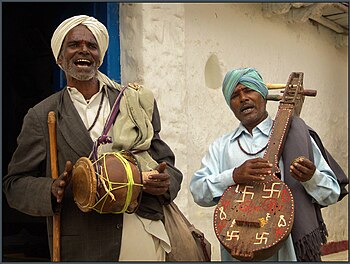 |
| Village musicians in Hyderabad singing and playing a drum and string instrument. The latter is decorated with swastika and aum signs. (Photo credit: Wikipedia) |
Sega - is an evolved combination of traditional Music of Seychelles,Mauritian and Réunionnais music with European dance music like polka and quadrilles.
Seggae - is a music genre invented in the mid 1980s by the Mauritian Rasta singer, Joseph Reginald Topize who was sometimes known as Kaya, after a song title by Bob Marley. Seggae is a fusion of sega from the island country, Mauritius, and reggae.
Semba - is a traditional type of music from the Southern-African country of Angola. Semba is the predecessor to a variety of music styles originated from Africa, of which three of the most famous are Samba (from Brazil), Kizomba (Angolan style of music derived directly from Zouk music) and Kuduro (or Kuduru, energetic, fast-paced Angolan Techno music, so to speak).
Shona Music - is the music of the Shona people of Zimbabwe. There are several different types of traditional Shona music including mbira, singing, hosho and drumming. Very often, this music will be accompanied by dancing, and participation by the audience.
Ska - is a music genre that originated in Jamaica in the late 1950s and was a precursor to rocksteady and reggae. Ska combined elements of Caribbean mento and calypso with American jazz and rhythm and blues.
Slow Jam - is typically a song with an R&B-influenced melody. Slow jams are commonly R&B ballads or just downtempo songs. The term is most commonly reserved for soft-sounding songs with heavily emotional or romantic lyrical content.
Soca - is a form of dance music that originated in Trinidad from calypso. It combines the melodic lilting sound of calypso with insistent (usually electronic in recent music) percussion.
Soukous - is a musical genre that originated in the two neighbouring countries of Belgian Congo and French Congo during the 1930s and early 1940s, and which has gained popularity throughout Africa.
Soul - is a music genre that combines rhythm and blues and gospel music, originating in the United States.
Taarab - is a music genre popular in Tanzania. It is influenced by music from the cultures with a historical presence in East Africa, including music from East Asia, Sub-Saharan Africa, North Africa, the Middle East and Europe. Taarab rose to prominence in 1928 with the rise of the genre's first star, Siti binti Saad.
Tango - is a style of music that originated among European immigrant populations of Argentina and Uruguay. It is traditionally played by a sextet, known as the orquesta típica, which includes two violins, piano, doublebass, and two bandoneons.
Waka - is a popular Islamic-oriented Yoruba musical genre. It was pioneered and made popular by Alhaja Batile Alake from Ijebu, who took the genre into the mainstream Nigerian music by playing it at concerts and parties; also, she was the first waka singer to record an album.
Wassoulou - is a genre of West African popular music, named after the region of Wassoulou. It is performed mostly by women, using lyrics that address women's issues regarding childbearing, fertility and polygamy.
Ziglibithy - is a style of Ivorian popular music that developed in the 1970s. It was the first major genre of music from the Ivory Coast. The first major pioneer of the style was Ernesto Djedje.
Zouglou - is a dance oriented style of music from the Côte d'Ivoire (Ivory Coast) that first evolved in the 1990s. It started with students (les parents du Campus) from the University of Abidjan.
Zouk - is a style of rhythmic music originating from the French islands of Guadeloupe and Martinique. It has its roots in kompa music from Haiti, cadence music from Dominica, as popularised by Grammacks and Exile One.
|



